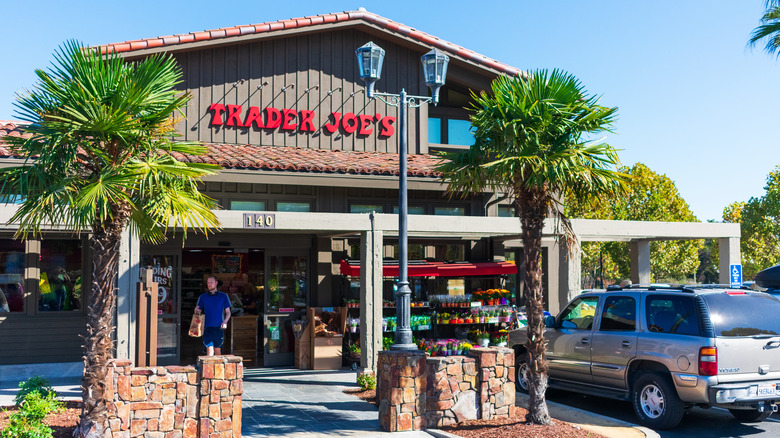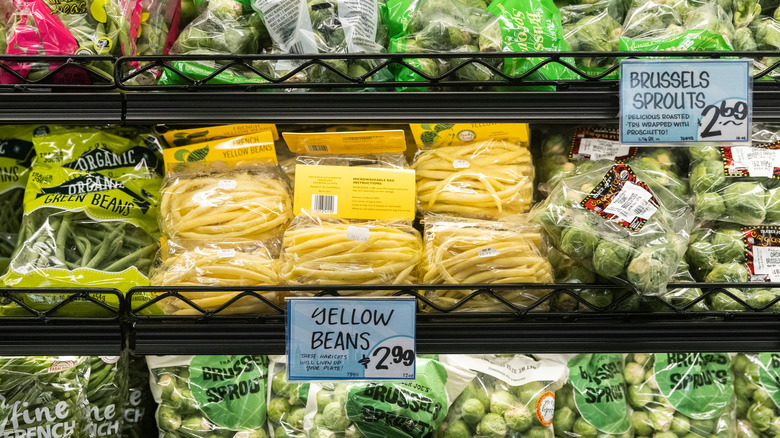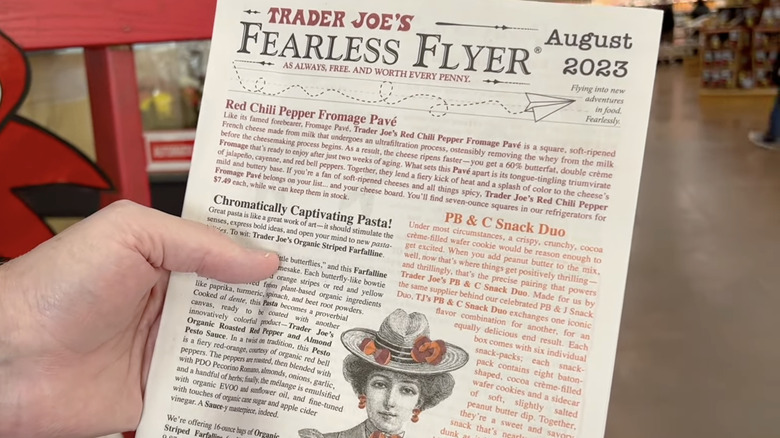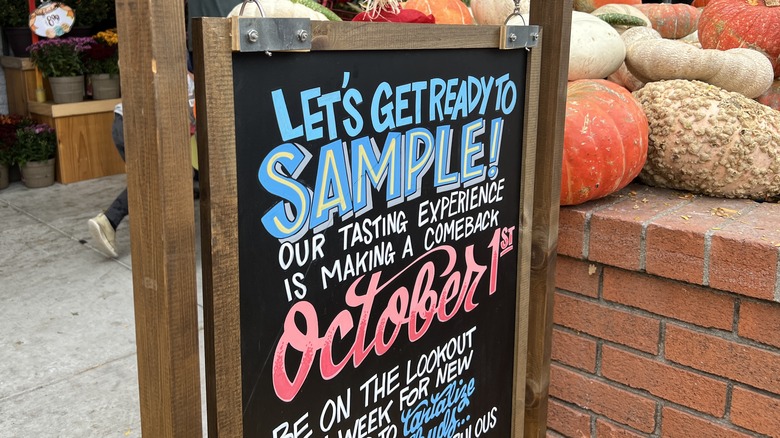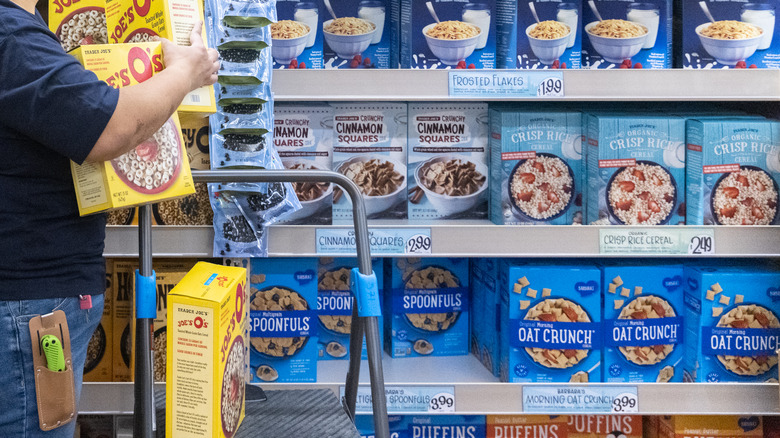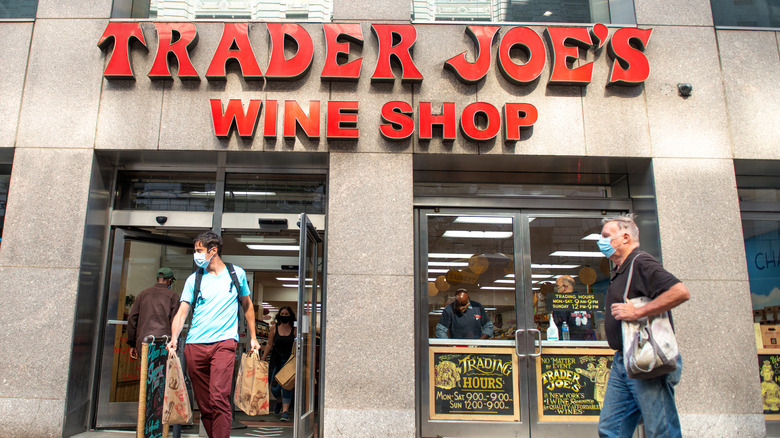Massive Mistakes That Are Costing You Extra Money At Trader Joe's
Named after its founder, Joe Coulombe, Trader Joe's is a quirky alternative to traditional grocery stores with a fun selection of international-themed and seasonal treats that you won't find anywhere else. The brand was originally started as a chain of convenience stores in the Los Angeles area, but fearing too much competition from market leader 7-Eleven, a shift was made to a more full-featured grocery store with a jet-setting mentality. Coulombe mentions getting inspiration from a Caribbean vacation, as well as the tiki culture that was sweeping across the United States at the time, including a suspiciously similar-sounding Polynesian restaurant called Trader Vic's.
The first store bearing the Trader Joe's name opened in Pasadena, California in 1967 and is still in business today. In 1979, the brand was sold to German businessman Theo Albrecht, owner of Aldi Nord, though fortunately, TJs continued to operate independently from Aldi stores.
Besides offering a bill of goods evocative of exotic lands, Trader Joe's is also heavily focused on value pricing, which frequently comes from dealing with suppliers directly and in large volume. Also, if a product isn't as popular as anticipated, it's quickly culled from shelves to make room for something else. Finally, customers must physically go inside the store to shop. There's no online shopping or delivery to add a layer of extra complication or expense. Seems simple enough, but there are a few pitfalls to avoid when maximizing your dollars and cents at TJs.
Buying your produce there
Trader Joe's is famous for selling bananas for just 19¢ each. While those bargain basement bananas may be one of the best deals that the retailer has to offer, that same value doesn't carry over to the rest of the produce department. That's because TJ's fruits and veggies have a reputation for going bad quicker than those from other grocery chains. Part of the reason for that is the store has a smaller, tighter network of growers than competitors, which is great for the farmers involved and cheaper for customers, but at the expense of inconsistent freshness and ripeness.
Another idiosyncrasy of TJ's produce department is the absence of scales. That's because produce is priced per item, not by weight like in more conventional grocery stores. In some cases like the bananas, that can represent a good deal but in other instances, not so much. Pricing per piece frequently results in a higher price per pound than other stores charge — even expensive stores like Whole Foods — and you'll be limited to purchasing the quantities that are prepackaged for you. That not only means that you can't just grab one piece of a fruit or vegetable, but also, the excessive plastic packaging used is neither cheap nor healthy for the environment.
If you're at Trader Joe's anyway, it's probably not worth your while to travel elsewhere just for a few produce items, but do make sure that you plan to use the ingredients sooner rather than later.
Not reading the Fearless Flyer before shopping
While other more conventional grocery stores have their weekly sales circulars, Trader Joe's does things a little differently. TJs has its "Fearless Flyer" newsletter that comes out approximately every month or two. The store's website describes the Fearless Flyer as not fitting "neatly into just one category. Is it a newsletter? A catalog? A comic-book? Yes, yes, and perhaps even yes!"
The one thing you won't find inside its pages is sales or coupons, because the store doesn't have them. What you will encounter is a cornucopia of Victorian-era artwork, over-the-top descriptions of new or seasonal products, and sometimes unconventional recipes to simplify mealtime, like Chicken Parm-ioli which combines refrigerated ravioli with chicken nuggets. Stores do have paper copies of the Fearless Flyer that you can peruse, but if you'd prefer to do your homework ahead of time, you can subscribe. Like its motto says, the Fearless Flyer is "always free and worth every penny."
Not asking for a product sample
Sure, even casual Trader Joe's shoppers are aware of the store's free samples, which have roared back triumphantly following a hiatus during the Covid-19 pandemic. TJs has dished out everything from fresh-brewed coffee to fried rice to cookies. But did you know that employees are authorized to crack open just about any product in the entire store if a customer requests a tasting? Officially, it's known as the "try anything" policy.
While it might be admittedly difficult to have a bite of that frozen Chicken Tikka Masala that you're eyeing, items like salads, chips, and even non-alcoholic beverages are ripe for sampling. You don't want to overdo it, though asking to audition one or two items is appropriate and probably best done at a less busy time when the store isn't packed to capacity with shoppers vying for employee attention.
In case you don't get a chance to try those Kung Pao Brussels Sprouts, TJs is also known for its generous return policy and will accept both opened items and items without a receipt. But seriously, why even make a return trip when you can do your taste testing right in the store before buying?
Ignoring the house brands
If you're not into trying some of Trader Joe's house brand items — everything from pasta sauce to ice cream — then you're probably better off shopping elsewhere. That's because over 80% of all items in the entire store are private-label brands. Trader Joe's first-ever private label item was granola way back in 1972, which makes sense when you consider the chain's California roots and the Golden State's penchant for heath food.
Although it may seem counterintuitive, the private label items give the store an unexpected air of exclusivity, with intriguing items that you won't find anywhere else, while at the same time allowing the retailer to keep its prices low. Since the early days of granola, product lines have expanded with playful names like Trader Jose for Mexican, Trader Giotto for Italian, and Trader Ming's for Chinese products, the latter of which makes fan-favorite Mandarine Orange Chicken.
Saving money on private-label brands doesn't mean skimping on quality, however. Reportedly, some of the chain's incognito suppliers include Tribe Mediterranean Foods, Naked Juice, and Tate's Bake Shop.
Not buying your alcohol there
Saving the best for last, who doesn't love a bargain on a decent bottle of wine? True to its nickname, Trader Joe's famous (or is it infamous?) "Two-Buck Chuck" lineup of wines first graced store shelves in 2002 with a low, low price of just $1.99 per 750ml bottle.
To set the scene for you, winemaker Charles Shaw found itself in financial dire straits in the late 1990s and was acquired by Bronco Wines, a subsidiary of boxed-wine giant Franzia. The decision was made to start selling Charles Shaw at ultra-discounted prices exclusively at Trader Joe's and the rest is history. In 2023, Two-Buck Chuck is now more like Four-Buck Chuck (prices vary by local market), but it's still a pretty solid deal, especially the Red Blend and Cabernet Sauvignon.
If you're not exactly a wine connoisseur, TJs also has many value-oriented private-label beers and spirits on offer, including its Trader Joe's Kentucky Bourbon, which is reportedly made by the well-known distillery Buffalo Trace. In the beer aisle, you'll find some fair-to-middling IPAs and Mexican lagers, but the real standouts are the seasonal selections like Tiramisu Pastry Stout and Howling Gourds Pumpkin Ale, all value-priced. Okay, now we're both hungry and dying to pop a beer.
